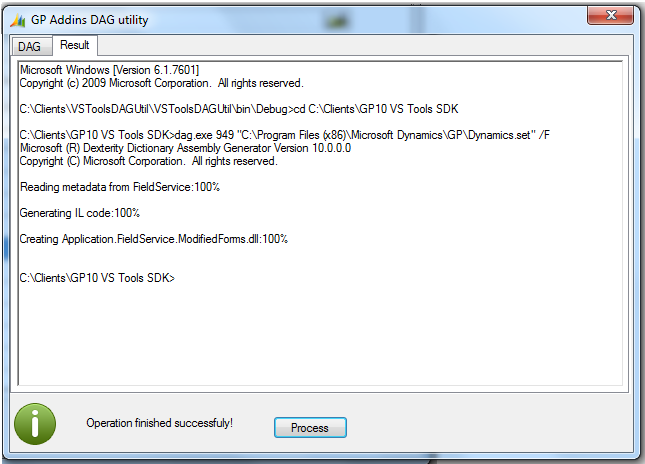Microsoft Dynamics GP Addins DAG Utility

Today, I have another treat for Visual Studio Tools developers.
After I posted the article: How to update Microsoft Dynamics GP Visual Studio Tools Addins on a live system, I was contacted by another community member, Srinivas Ramidi. He has created a little utility that makes using the DAG (Dictionary Assembly Generator) tool easier by providing a Graphical User Interface (GUI) to the tool.
Srinivas was graciously willing to share his utility and asked if I could post it.
Srinivas Ramidi is a developer since 2003 and currently works on the Microsoft Dynamics GP at InterDyn BMI (www.interdynbmi.com), a Microsoft Certified Gold Partner since 2006. At InterDyn, he mostly work on the customizations and integration projects. His part-time love is looking around at new technologies, finding better ways for design and development.
I will let Srinivas explain what the utility does....
Disclaimer: This utility is not supported by Microsoft. The code is written by a third party (Srinivas) is provided "as is" and no warranty is given or implied.
Have you ever thought how easy it would be if we have a user interface for creating managed code assembly for integration projects?
Well, here is the utility for you.
The GP Addins DAG Utility is developed in Visual Studio 2008 C#. It has been created to build an application assembly for the main dictionary or forms dictionary and works with Microsoft Dynamics GP 10.0 and GP 2010 SDK (Software Development Kit).
As you many of you know we have to use Dictionary Assembly Generator (DAG.exe), a command-line tool which is included with Visual Studio Tools for Microsoft Dynamics GP that creates a managed code assembly that provides access to resources in an application dictionary. Sometimes it is difficult to remember the syntax or find the correct Product ID to create the assembly.
To make the process easy, this utility will give you all the options to select the product and it lets you to choose custom forms or main dictionary and format the correct command. It requires you to set the path to the SDK Folder and DYNAMICS.SET file. These settings are stored in a config file, so they are remembered for next time the utility is used.
Below are some screenshots of the utility in action:
Note: This utility does not support overriding the application assembly name, or signing an assembly.
The utility with its documentation is available from the following link:
I hope you enjoy this free utility. Please join me in thanking Srinivas for his work and post a thank-you comment.
David

